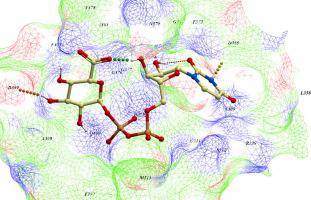Bioorganic & Medicinal Chemistry ( IF 3.3 ) Pub Date : 2021-02-20 , DOI: 10.1016/j.bmc.2021.116060 Ingmar Trane 1 , Georg Sager 2 , Erik Sveberg Dietrichs 3 , Aina Westrheim Ravna 2

|
The dominant sex hormone testosterone is mainly metabolized by liver enzymes belonging to the uridine-diphospho (UDP) glucuronosyltransferase (UGT) family. These enzymes are the main phase II enzymes, and they have an important role in the detoxification of endogenous and exogenous compounds in humans. The aim of the present study was to improve the understanding of the binding properties of UGT2B17. A homology modelling procedure was used to generate models of the UGT2B17 enzyme based on templates with known crystal structures. Molecular docking of inhibitors was performed to gain further insights in the interactions between ligand and binding site, and to determine which of the models had the best accuracy. ROC curves were made to evaluate the ability of the models to differentiate between binders (inhibitors) and non-binders (decoys). When comparing the four models, which were based on four different crystal structures, the model based on the 4AMG crystal structure was the most accurate in distinguishing between true binders and non-binders. Investigating pharmacological UGT2B17 inhibition may provide novel treatment for patients with low testosterone levels. Such treatment may elevate endogenous testosterone levels and provide a more predictable increase in serum concentrations rather than un-physiological elevation of serum levels through direct treatment with testosterone, and this could be favorable both for giving a predictable treatment regime with reduced chances of serious adverse effects. The present study may serve as a tool in the search for novel drugs aiming for increasing testosterone levels.
中文翻译:

睾酮代谢酶UDP-葡萄糖醛酸转移酶2B17的分子模型研究
占主导地位的性激素睾酮主要由属于尿苷二磷酸 (UDP) 葡萄糖醛酸转移酶 (UGT) 家族的肝酶代谢。这些酶是主要的II相酶,它们在人类内源性和外源性化合物的解毒中具有重要作用。本研究的目的是提高对 UGT2B17 结合特性的理解。同源建模程序用于基于具有已知晶体结构的模板生成 UGT2B17 酶的模型。进行抑制剂的分子对接以进一步了解配体和结合位点之间的相互作用,并确定哪个模型具有最佳准确性。制作 ROC 曲线以评估模型区分结合剂(抑制剂)和非结合剂(诱饵)的能力。当比较基于四种不同晶体结构的四种模型时,基于 4AMG 晶体结构的模型在区分真正的粘合剂和非粘合剂方面最准确。研究抑制 UGT2B17 的药理学可能为睾酮水平低的患者提供新的治疗方法。这种治疗可能会提高内源性睾酮水平并提供更可预测的血清浓度增加,而不是通过直接用睾酮治疗血清水平的非生理性升高,这可能有利于提供可预测的治疗方案,减少严重不良反应的机会. 本研究可作为寻找旨在提高睾酮水平的新型药物的工具。基于四种不同的晶体结构,基于 4AMG 晶体结构的模型在区分真正的粘合剂和非粘合剂方面最准确。研究抑制 UGT2B17 的药理学可能为睾酮水平低的患者提供新的治疗方法。这种治疗可能会提高内源性睾酮水平并提供更可预测的血清浓度增加,而不是通过直接用睾酮治疗血清水平的非生理性升高,这可能有利于提供可预测的治疗方案,减少严重不良反应的机会. 本研究可作为寻找旨在提高睾酮水平的新型药物的工具。基于四种不同的晶体结构,基于 4AMG 晶体结构的模型在区分真正的粘合剂和非粘合剂方面最准确。研究抑制 UGT2B17 的药理学可能为睾酮水平低的患者提供新的治疗方法。这种治疗可能会提高内源性睾酮水平并提供更可预测的血清浓度增加,而不是通过直接用睾酮治疗血清水平的非生理性升高,这可能有利于提供可预测的治疗方案,减少严重不良反应的机会. 本研究可作为寻找旨在提高睾酮水平的新型药物的工具。基于 4AMG 晶体结构的模型在区分真正的粘合剂和非粘合剂方面是最准确的。研究抑制 UGT2B17 的药理学可能为睾酮水平低的患者提供新的治疗方法。这种治疗可能会提高内源性睾酮水平并提供更可预测的血清浓度增加,而不是通过直接用睾酮治疗血清水平的非生理性升高,这可能有利于提供可预测的治疗方案,减少严重不良反应的机会. 本研究可作为寻找旨在提高睾酮水平的新型药物的工具。基于 4AMG 晶体结构的模型在区分真正的粘合剂和非粘合剂方面是最准确的。研究抑制 UGT2B17 的药理学可能为睾酮水平低的患者提供新的治疗方法。这种治疗可能会提高内源性睾酮水平并提供更可预测的血清浓度增加,而不是通过直接用睾酮治疗血清水平的非生理性升高,这可能有利于提供可预测的治疗方案,减少严重不良反应的机会. 本研究可作为寻找旨在提高睾酮水平的新型药物的工具。这种治疗可能会提高内源性睾酮水平并提供更可预测的血清浓度增加,而不是通过直接用睾酮治疗血清水平的非生理性升高,这可能有利于提供可预测的治疗方案,减少严重不良反应的机会. 本研究可作为寻找旨在提高睾酮水平的新型药物的工具。这种治疗可能会提高内源性睾酮水平并提供更可预测的血清浓度增加,而不是通过直接用睾酮治疗血清水平的非生理性升高,这可能有利于提供可预测的治疗方案,减少严重不良反应的机会. 本研究可作为寻找旨在提高睾酮水平的新型药物的工具。











































 京公网安备 11010802027423号
京公网安备 11010802027423号